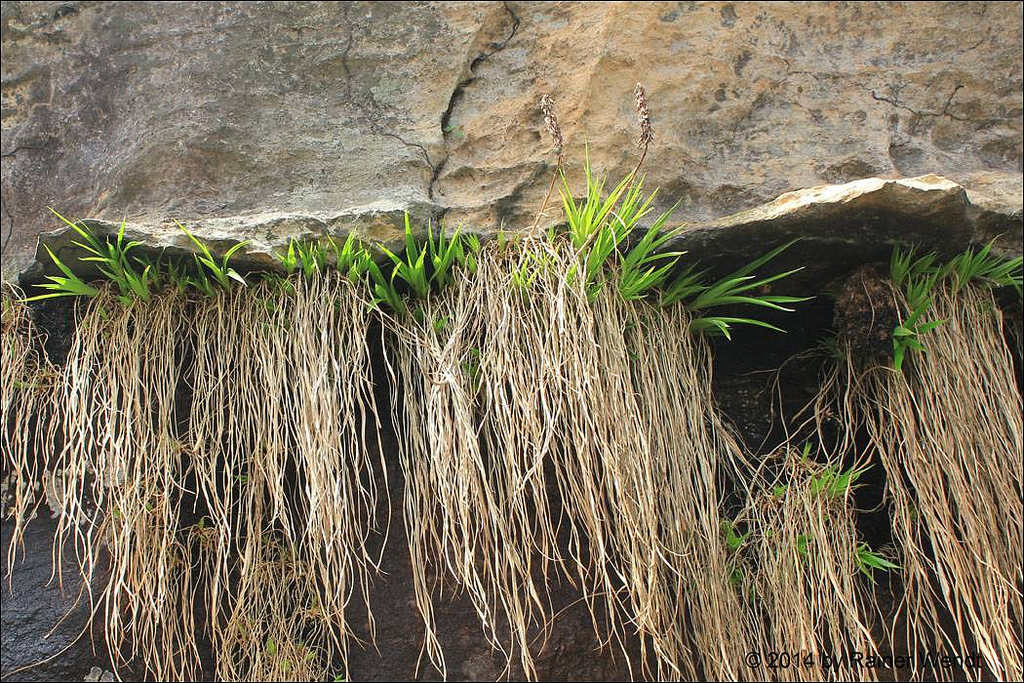The happy plant that escaped to Africa
Nestled on the west coast of Africa, a plant lives 3000 km from its 3000 relatives. Most bromeliads are relatively similar in shape but take on a wide variety of habitats in the neotropics. Except one. Meet Pitcairnia feliciana.
Sure, these days we see pineapples (the most famous bromeliad) cultivated around the world; but outside of the Americas, they are introduced species. Yes, many of us may have bromeliads in our homes or have seen them in waiting rooms; again, these have been marched across the planet through the horticultural trade. P. feliciana is the only known species in the family, out of three thousand, to naturally occur in the old world.
Pitcairnia feliciana – which I like to think of as the Happy Pitcairn – is native to Guinea, in West Africa. It shares the morphology other Pitcairnia bromeliads: long floppy-looking, strap-like leaves, arranged in a rosette pattern at the base of the plant. Unlike many of its relatives that populate the canopies of neotropical rainforests, P. feliciana is a lithophyte, anchoring itself between cracks in rocks.
 Bromeliads are thought to have arisen in northeastern South America around 100 million years ago. South America and Africa were much closer to each other back then, however it doesn't look like any bromeliads crossed the Atlantic at that time. To begin with, the Pitcairnia genus seems to have originated in the Andes 15 million years ago and spread around the continent from there. By that time, the Atlantic was nearly as wide as it is today, even in spite of a drop in sea level at the Brazilian coast 15-10 million years ago while sea levels elsewhere reached rose. Instead, the lineage from which P. feliciana sprouted dispersed to West Africa 9.3 million years ago.
Bromeliads are thought to have arisen in northeastern South America around 100 million years ago. South America and Africa were much closer to each other back then, however it doesn't look like any bromeliads crossed the Atlantic at that time. To begin with, the Pitcairnia genus seems to have originated in the Andes 15 million years ago and spread around the continent from there. By that time, the Atlantic was nearly as wide as it is today, even in spite of a drop in sea level at the Brazilian coast 15-10 million years ago while sea levels elsewhere reached rose. Instead, the lineage from which P. feliciana sprouted dispersed to West Africa 9.3 million years ago.Pitcairn bromeliads are especially drought-tolerant and do well in poor soils. Therefore, it is thought that the plants might have rafted some of the way across the Atlantic.
Of course, today there are incredible transatlantic voyagers like sharks and whales and turtles – but as astounding as that is, they are big, strong marine animals. We're talking about a little terrestrial plant, accidentally and passively crossing the second largest ocean on the planets. It seems extraordinary to think, but bromeliads are not the only plants to have defied the challenge the Atlantic Ocean provides to dispersal. Members of the daisy family, Asteraceae, are thought to have spread from South America to Africa 50 million years ago, although the continents would have been a little closer to each other at that point.
An impressive feat nonetheless. Although whenever I describe bromeliads as a "neotropical family of plants", I feel guilty trying not to imagine the lonely P. feliciana clinging to a rock face in Guinea.
Glossary
Lithophyte - A plant that grows on rocks or stone.
Epiphyte - A plant that grows on other plants.
Images:
https://www.flickr.com/photos/86810854@N06/14626825451
http://www.westafricanplants.senckenberg.de/root/index.php?page_id=14&id=2587#image=8066
Bibliography
- Katinas, L. et al (2013).Trans-oceanic dispersal and evolution of early composites (Asteraceae). Perspectives in Plant Ecology, Evolution and Systematics, 15(5): 269-280
- Rossetti, D. F. et al (2013) Late Oligocene–Miocene transgressions along the equatorial and eastern margins of Brazil. Earth-Science Reviews, 123: 87-112
- Porembski, S., & Barthlott, W. (1999). Pitcairnia feliciana: The only indigenous African bromeliad. Harvard Papers in Botany, 4(1): 175-184.
- Givinish, T. J. et al. (2014). Adaptive radiation, correlated and contingent evolution, and net species diversification in Bromeliaceae, Molecular Phylogenetics and Evolution. 71: 55-78
- Saraiva, D. P. et al (2015). Insights into the Evolution of Pitcairnia (Pitcairnioideae-Bromeliaceae), Based on Morphological Evidence, Systematic Botany. 40(3): 726- 736






Very interesting.
ReplyDeleteดูหนังออนไลน์